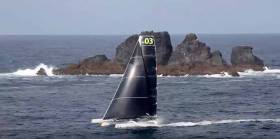Displaying items by tag: The Great Foze Rock
Ireland Considered Ceding Atlantic Rock To Portugal
A rocky Irish islet in the Atlantic, a steep little place where former Taoiseach Charlie Haughey and his family and friends once partied, faced being ceded to Portugal last autumn following close examination of current Round Ireland record footage.
Afloat.ie has learned that late last summer, an influential group had made approaches to Portugal in order to maintain the validity of the new Round Ireland Record as established by the MOD 70 Phaedo 3. The special group in Ireland was unaware that World Sailing Speed Records do not include the Great Foze Rock west of the Blaskets as being included in the round Ireland record course. In their enthusiasm to uphold the new record, the group was prepared to cede Irish territory to Portugal.
As a result, The Great Foze Rock – the furthermost outcrop of the Blasket Islands, and the most westerly part of Ireland after Rockall – was in future to be known as Grande Ilheu de Foze. And instead of being part of the Blaskets, it was to be included in the Arquipelago dos Acores (Azores Archipelago).
But further research revealed a slightly confused situation between the two main round Ireland sailing projects. The biennial Volvo Round Ireland Race from Wicklow simply states that the course is round Ireland clockwise, leaving Ireland and all her islands except Rockall to starboard, and it specifically names the Great Foze Rock and the nearby Little Foze Rock, as they are the most westerly marks of the Round Ireland Race course.
However, the Round Ireland Record as administered by the WSSR has a different set of rules (and a different course distance too, as they reckon it’s 698 miles, whereas from Wicklow it’s 704). The official record is started from a line off Dublin Bay between the Kish Lighthouse and the lighthouse on Dun Laoghaire South Pier, and you can go in either direction.
Going anti-clockwise like Phaedo 3, the officially-designated course is Rathlin Island, Tor Rock at Inishtrahull, Tory Island, Eagle Island, Tearaght Island, Great Skellig, Fastnet Rock, Coningbeg Rock, Tuskar Rock and finish.
Thus it looks as though WSSR does not think of the Great Foze Rock as being worthy of consideration as part of Ireland. But the people of Kerry need not feel personally offended by this, as up in County Antrim they have a similar grievance. The Maidens Rocks northeast of Larne, which are large enough to have a lighthouse and a couple of supporting houses, likewise aren’t mentioned as a Round Ireland Record mark of the course.
Be that as it may, the situation which highlighted the situation regarding the Great Foze arose early in August 2016, when the current record was being established. The superb film and photographic images of the record-breaking MOD 70 Phaedo 3 sweeping southwards past the Blasket Island of lighthouse-equipped Inishtearaght, then speeding on to pass to seaward of Skellig Michael, showed that in order to get the most dramatic images from being as close as possible to Inishtearaght, Phaedo 3 sailed inside the 27-metre high Great Foze Rock, which is 0.8 miles to the westward of Tearaght.
This is some of the finest footage ever shot of sailing off the Irish coast, with a couple of seconds showing Phaedo passing to the eastward of the great Foze Rock to position herself for a dramatic sail-past at Tearaght Island and the Great Skellig – followed remarkably quickly by the Fastnet itself, which was 60 miles further on.
This is no way lessened the total distance sailed to set the new record. But Round Ireland Race veterans – particularly those whose memories go back to pre-GPS days – will be well aware that staying clear outside the unmarked and unlit Great Foze was always something of a navigational challenge when sailing through what could be the roughest waters experienced on the entire course. Naturally, they were surprised to learn that this storm-tossed outcrop is not part of the Round Ireland Record course.
However, in the most windless and swell-free summer weather, it is just possible to land on The Great Foze. Many years ago, in admittedly almost unbelievably calm conditions, former Taoiseach Charlie Haughey with some family and friends zoomed out there aboard a RIB from their summer home on the Blasket Island of Inishvickillane, and managed to land on the Great Foze and have a bit of a party.
In the best traditions of Blaskets hospitality, when they headed for home they left behind a bottle of Cork Dry Gin and some glasses for the next visitors. But over the years, they never heard of anyone who had been able to enjoy the benefits of their thoughtful gesture.





























































